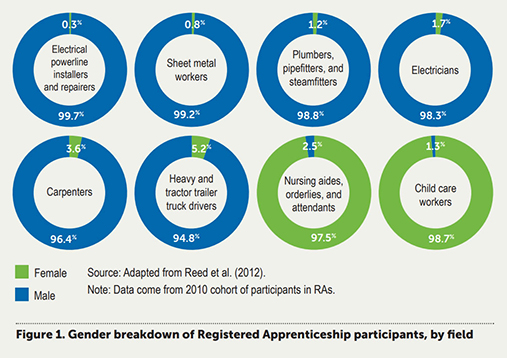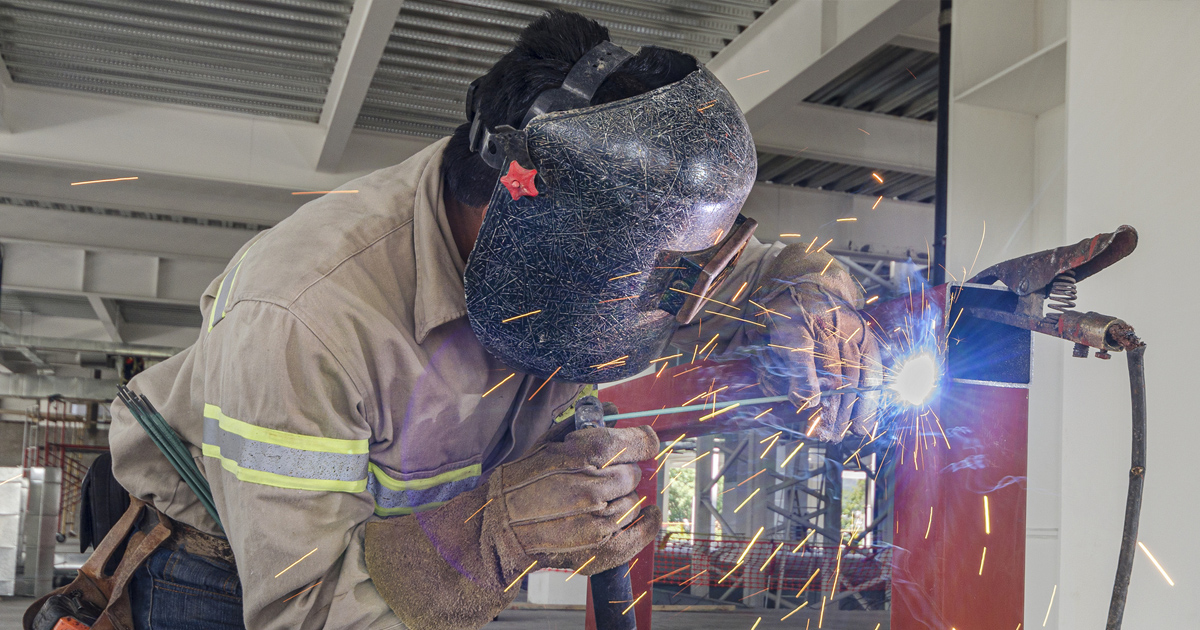Despite the steady increase in female labor force participation, women remain concentrated in health and personal care, as well as education, while craft and technical occupations remain male dominated. That’s not necessarily problematic, except predominantly female occupations tend to have the lowest earnings and predominantly male occupations the highest, even though the general skill requirements for these jobs are similar.

Photo by Dawn Jones Redstone for the Tradeswomen Image Library used under Creative Commons license
To encourage workers to train for jobs where there is a market demand, the U.S. Department of Labor funds or administers a variety of training programs. These programs help provide opportunities for men and women to obtain skills that help them find a job in a new industry or move up to a higher paying job in their field. However, we recently found that these same federally-funded training programs tend to cluster women into occupations which have traditionally been predominantly female, and pay less. So rather than helping to expand opportunities for women and close the pay gap, too often the training simply reinforces existing pay disparities.
There are a number of factors which could contribute to disproportionality in certain fields, and the kind of grouping we found in training programs. For example, many participants, career counselors, and training providers continue to put stock in deeply held—and deeply misguided—stereotypes of “appropriate” jobs for men and women. Limited employer outreach to women and lack of available information about “non-traditional” jobs could also play a role. In some cases women may face greater difficulty gaining the specific prerequisite skills needed to advance further in vocational training programs. Not to mention the added challenge of being a pioneer in a male-dominated work environment.

In addition, the methods programs use to recruit participants, provide training, and place them in jobs might pose additional barriers. For example, participants in Registered Apprenticeships often are recruited through the social networks (in person and online) of existing employees. Many of these programs are extremely competitive, with interest far outweighing availability. As a result, women might have less access to apprenticeships because they are less likely to be in the social networks of the men already in the male-dominated occupations.
So what can workforce development partners do to help close the pay gap by recruiting, training, and retaining women in non-traditional jobs?
1. Expand opportunities for women within training and apprenticeship programs
- Set targets for the number of women participants expected to enroll in training and apprenticeship programs.
- Increase the use of general outreach strategies, such as advertisements in newspapers, the internet, and social media, to supplement recruiting through social networks.
- Use advertisements that have gender-neutral language and images of real women in skilled trades, to encourage women applicants.
2. Improve skill assessment and increase awareness of non-traditional occupations
- Adopt gender-neutral skill testing to identify transferable skills that women can bring to skilled-trade occupations.
- Use informative material to tackle women’s perceptions of their inability to perform male-dominated jobs.
- Offer informative sessions that provide women with knowledge about the actual requirements of a specific trade and familiarity with tools used in skilled trades.
3. Encourage greater choices around different fields
- Educate women, especially those without work experience, about the pay in different types of jobs and the income necessary to sustain a family (especially as a single mother).
- Encourage participants to explore occupational information on at least one nontraditional occupation for their gender.
- Offer subsidies to individuals for training in nontraditional fields.
4. Take pre-emptive steps to help keep women in training and apprenticeship programs
- When possible, offer training programs with a flexible schedule to allow trainees with family care responsibilities to participate.
- Help apprentices find affordable child care during their apprenticeship/training by offering child care vouchers.
- Help training providers and sponsors educate their staff about gender stereotypes and hidden biases.
- Provide mentorship to women in male-dominated fields.
5. Work with employers to improve the on-the-job experience for women
- Inform employers in male-dominated fields about benefits of having more women workers, such as improved workplace health and safety.
- In job advertisements, display images of real female bosses and company owners as potential employers.
- Help employers create policies to prevent harassment and discrimination at worksites.
- Help employers enforce more monitoring of adherence to existing anti-discrimination policies.
Federally-funded training programs are designed to help individuals get the skills they need to enter or re-enter the labor market. These programs also present a tremendous opportunity to improve women’s earning potential and help close the persistent gender pay gap.


